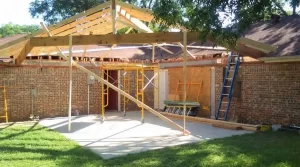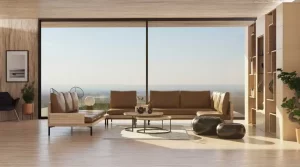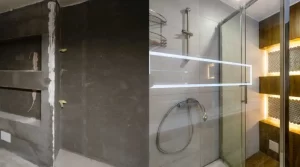If you’re going to build a custom home in the future, you might have to decide whether to use solid beams or box beams, also known as wrapped beams, in some feature spaces. You should consider the following factors before making this decision.
Aesthetic
Using solid beams gives you the option of a rustic, aged look or a clean-lined, more transitional design. One of the key advantages of using solid beams in applications that call for extremely long beams is the lack of any seams. Often only available in lengths between 14′ and 16′, box beams require a trim carpenter or timber/beam manufacturer to assemble boards. If you look closely, the seam is usually still visible even though a skilled carpenter and painter can successfully hide it by matching the grain and coloring it. Yet, if you’re working with an expert, high-quality builder or carpenter, the mitered edge seams should be completely disguised.
Usually speaking, box beams perform better in transitional and simplified designs. They are also the preferred beam when you would rather have the finished beam painted rather than stained because you don’t have to match the graining and can choose a more affordable wood species. For an old, hand-hewn appearance, employing box beams rather than solid beams often results in minimal cost savings. When constructing or creating a unique home from scratch, those looking for beams with an antique aspect frequently choose solid ones.
Application
In remodels or repairs, solid beams are generally not an option because the original structure was not designed to support the greater weight of solid timbers. Box beams can be employed in the majority of rehabilitation projects because they are only aesthetically pleasing and never structural. On the other hand, solid beams might only be decorative or useful. Douglas Fir is the solid timber species most famous for its tensile strength. When used to surround structural materials like a steel I-beam or Glulam, box beams can be custom-milled to match solid beams. Also, this is useful if a certain beam has to hide electrical or plumbing chases.
Solid beams can be used both inside and outside, however, box beams should only be used indoors, especially in humid regions (like Houston, Texas). Due to changes in temperature and moisture in Houston’s humid climate, box beam ends and edges may expand, cup, or detach.
Price
Painted box beams are the most economical choice for interior decorative beams. If you’d prefer stained, you can still cut costs by choosing box beams produced by an expert trim carpenter, but be sure to check with your custom builder to be sure they have a lot of experience mitering edges and successfully concealing seams. Although solid oak beams are among the most expensive options, they are your best choice if you want to achieve a rustic, weathered aesthetic.
When choosing between solid beams and box beams for your custom home, consulting with your architect, interior designer, and custom builder is the best course of action. Your bespoke builder will be able to provide you details on the price and availability of wrapped beam planking, solid timber prices, and whether their trim carpenters can simulate a solid beam in a box beam application. Throughout this process, as is typically the case, your selected custom builder should be a trustworthy resource, advisor, and advocate for you and your family.







